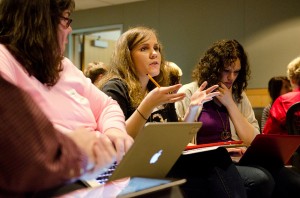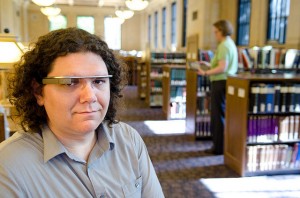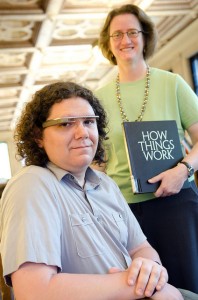Digital Art Sciences + Humanities initiative propels research forward
By Laura Krueger Vitko
Faculty demonstrate the use of 3-D printing to replicate artifacts and bring digital designs to life as physical objects. Students use Google Glass to explore artifacts at the Bell Museum of Natural History through state-of-the-art perspectives. A professor uses text-mining tools to uncover new ways of reading and understanding literary masterpieces. A history class uses digital exhibits, mapping technology, and interactive timelines to build multifaceted interpretations of the past.
These are just a few examples of projects that Justin Schell supports in his role as the University of Minnesota Libraries Digital Humanities Specialist.
Schell, who has a doctorate in comparative studies in discourse and society, describes himself as a hybrarian – or hybrid librarian. He developed his background in digital humanities and library science through a number of paths, including his work as a Digital Content Library Fellow for CLA-OIT, his own multimedia and online Ph.D. dissertation, and his work at the Immigration History Research Center (IHRC).
At the IHRC, which functions both as an archival unit and a research center, Schell helped implement the center’s first digital humanities project, Minnesota 2.0.
Donna Gabaccia, professor of history and former director of the IHRC, said that the experience of bridging scholarly research with archival practices was influential to Schell’s pursuit of the libraries profession.
“From his work with digital humanities research and archives at the IHRC, he developed the idea where libraries were actively working with digital humanities projects,” she said.
A cross-disciplinary initiative
 Since joining the Libraries in 2013, Schell has been working with other staff to advance the Digital Arts Sciences + Humanities (DASH) initiative. DASH’s foundation is based in the broadly scoped and growing field of digital humanities, where the disciplines of the humanities and computing intersect, allowing for a broader – and often different – understanding of data.
Since joining the Libraries in 2013, Schell has been working with other staff to advance the Digital Arts Sciences + Humanities (DASH) initiative. DASH’s foundation is based in the broadly scoped and growing field of digital humanities, where the disciplines of the humanities and computing intersect, allowing for a broader – and often different – understanding of data.
For example, Schell said, digital humanities projects can study culture from a humanistic perspective or bring computational methods – like text mining, data mining, or mapping technology – to humanistic questions.
DASH goes beyond traditional digital humanities to incorporate the interdisciplinary and data-driven work of the digital arts and sciences.
Schell explained that uniting these three fields was natural because a critical engagement with data is applied to research in the arts, sciences, and humanities.
“In talking about something as fundamental as data, data is never raw,” he said. “There are always choices being made in how data is collected, recorded, and interpreted. It is not just objective research — there are meanings and interpretations being made all of the time.”
Libraries: A space for discovery
It may come as a surprise to some that the University Libraries are building the capacity to support digital arts, sciences, and humanities projects. But as a neutral ground that serves all disciplines across the University, the Libraries are well equipped to fill this need.
“The Libraries serve everyone at the University,” said Haven Hawley, former assistant professor of history of science and technology. “The Libraries are the one place where everyone can meet. And we need a place that advocates for more access — to the data, the knowledge of resources, and the technical capacity.”
Schell serves as a point person for interested scholars to contact when they want to learn more about digital humanities tools and obtain guidance on building a research or course project. Schell, also works with library experts in data management and preservation, copyright, visualization, metadata, geospatial information, and digital systems to provide direction and training.
“Libraries are not just a place that has books, but are more about curating information in a moment when there is so much information available to people. And helping people understand new ways of providing that information and using that information,” said Schell. “The Libraries are a space for discovery. That’s why libraries are so well positioned for this type of research — not just to assist with these projects but to really take the lead in exploring them.”
Building communities of practice
The wide-ranging scope of DASH-supported methodologies includes text and data mining, digital archives, GIS, spatial research, data visualization, critical code and algorithm studies, data arts, digital storytelling, and multimodal scholarship. DASH also supports projects that utilize or critically engage with mobile app development, desktop fabrication, 3-D printing, and makerspaces.
To meet the demand for hands-on training with a variety of digital humanities tools, Schell facilitates DASH workshops, provides customized instruction, and organizes community building events with faculty and researchers. One of the goals of hosting activities that are open to all of the University is bridging the disciplinary boundaries that exist at large academic institutions.
A key to DASH’s success has been building a community of researchers across departments, who discover how others are using the same digital tool for different things, learn about new projects on campus, and get inspired by each other.
“The DASH events are that space where we can have an English professor, a graduate student, and a researcher from electrical engineering talking about similar things,” Schell said. “It’s a culture of serendipity that can arise from those spaces — by bringing those people together to see what new ideas can emerge. That’s what DASH is really all about.”
DASH in the classroom
Instructors on campus are increasingly interested in bringing DASH tools and methods into the classroom. Schell works with a number of classes to assist with digital tool selection and training, provide guidance on translating research into digital projects, and identify technical resources for hosting digital projects.
Schell also provides pedagogical support, and assisted with the revision of professor Gabaccia’s “How to Do History” course to “How to Do Digital History.” In this course, groups of undergraduate students created interactive history projects that incorporated timelines, maps, and digital stories.
Gabaccia explains that institutional lessons can be learned from Schell’s partnership at multiple points during the course.
“In the class planning stage, Justin and I created a list of existing projects to serve as inspiration that were created with digital tools or were representations of history using digital tools,” she said. “Then Justin assisted by teaching students the concept of visualizing data and how to manage resource materials with digital tools, such as Zotero.
“Justin was also our technical support, and he identified digital tools that could be used for the student projects, such as tools available for creating interactive timelines and mapping tools” said Gabaccia. “He also provided input on new evaluation approaches and methods for getting student feedback for the digital projects.”
Hawley said that roles like Schell’s are essential to growing the use of digital humanities tools and methodologies in University courses.
“It can be difficult for faculty to upscale their knowledge and to gauge how much effort to put into a new pedagogical process. We need people who can work as a team with faculty,” said Hawley. “This scholarly and technical type of support is not an IT responsibility. Justin is someone who can bridge the field of library science with professional knowledge of the digital humanities and with technical skills.”
With the DASH initiative, Burroughs and Schell are building a connected infrastructure and growing a team of participants to expand and sustain support for digital arts, humanities, and sciences projects on campus. And this is for the benefit of many. Schell said that one of the main outcomes of DASH collaborations is producing new knowledge for all researcher partners at the University.
“It’s this way of bringing humanistic elements to these other disciplines,” said Schell. “But at the same time it’s learning from these other disciplines and creating bridges between them so that there are not three separate camps of artistic knowledge, scientific knowledge, and humanistic knowledge.”
By locating DASH at these intersecting points of knowledge, the initiative propels new interdisciplinary and transdisciplinary research forward.






